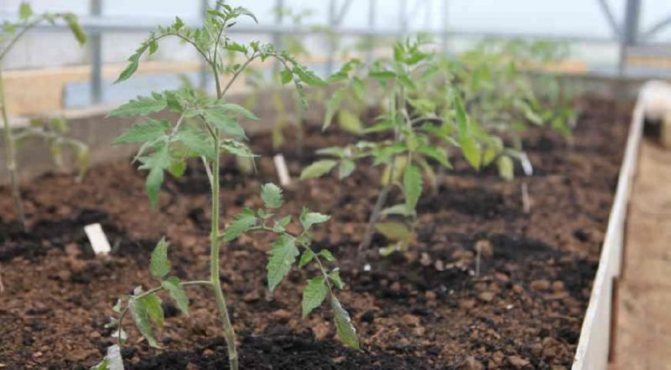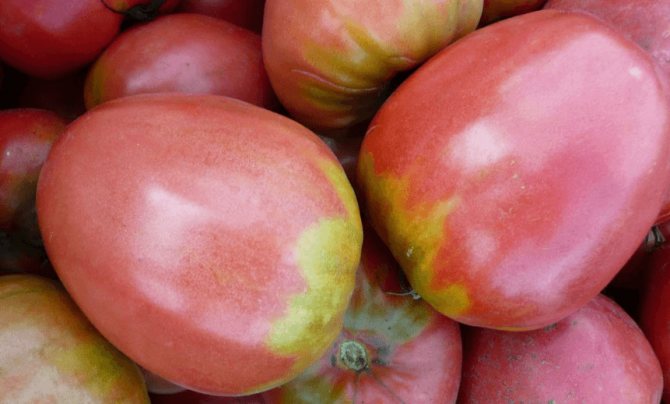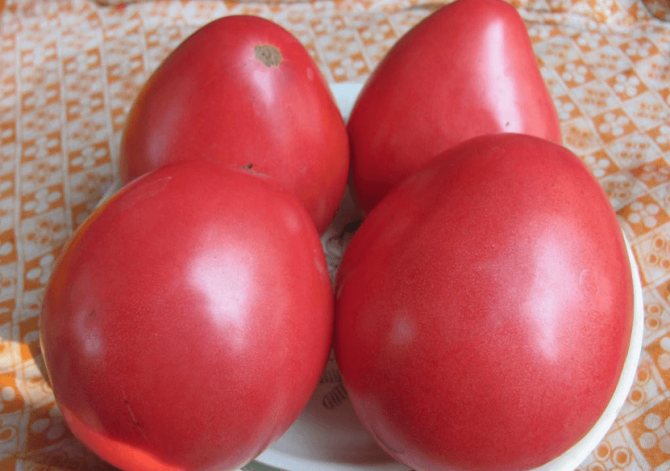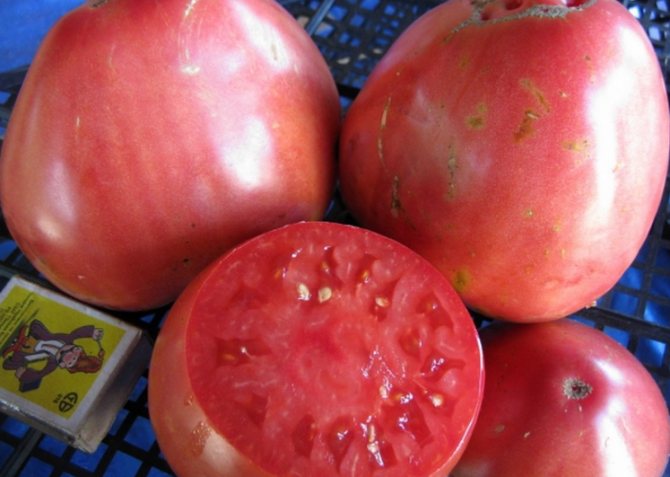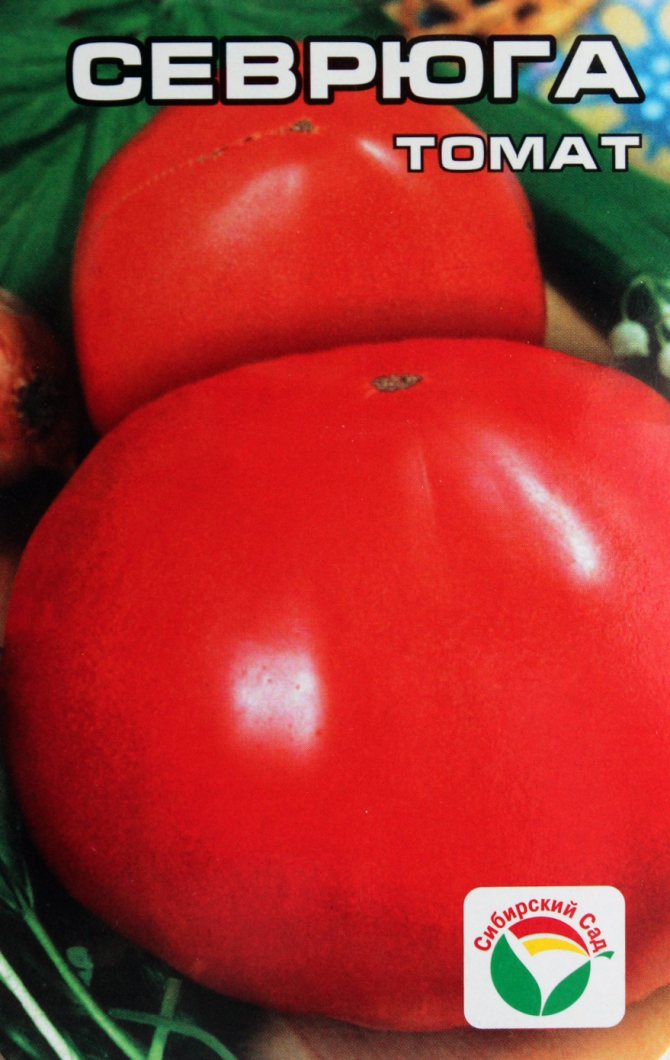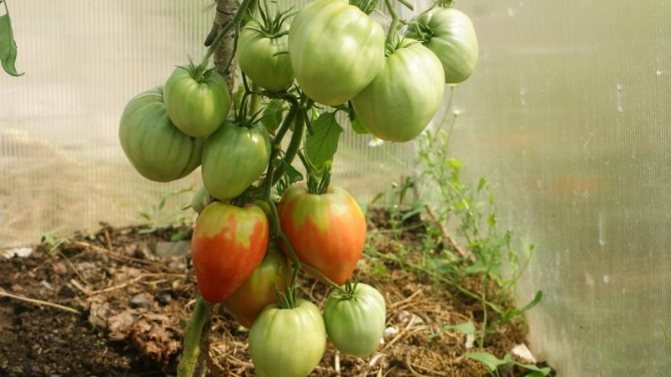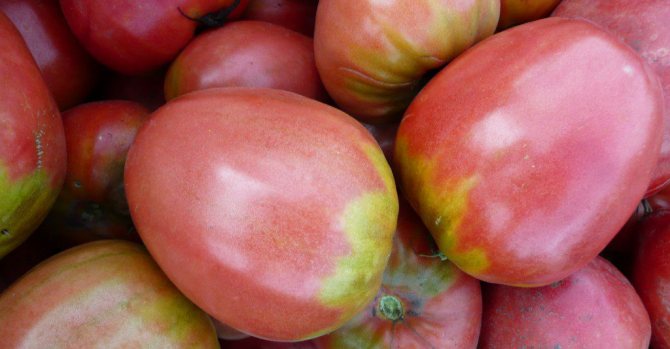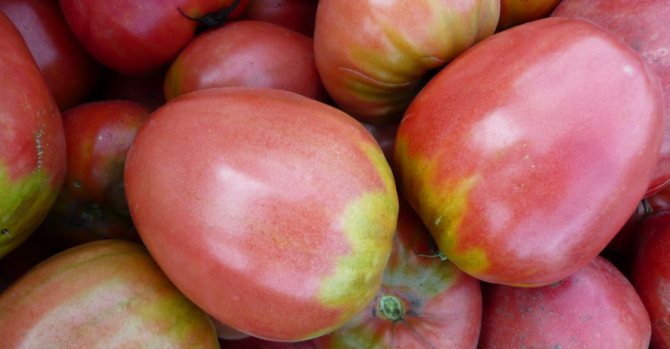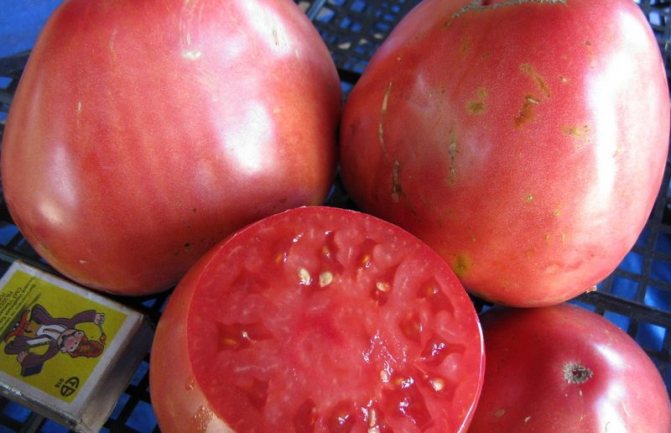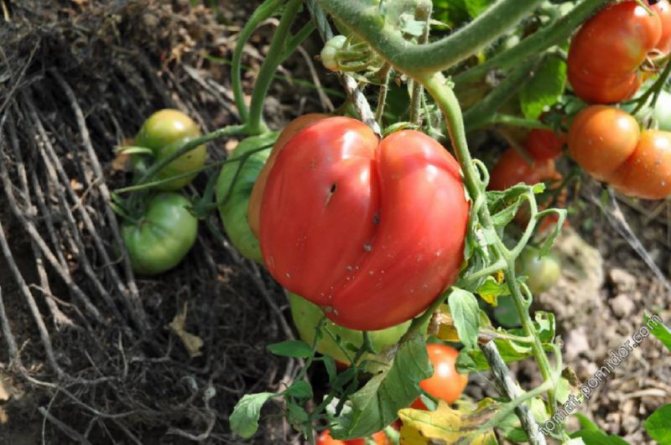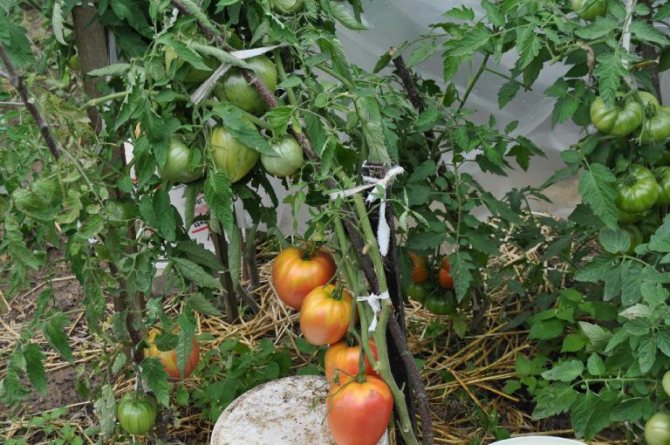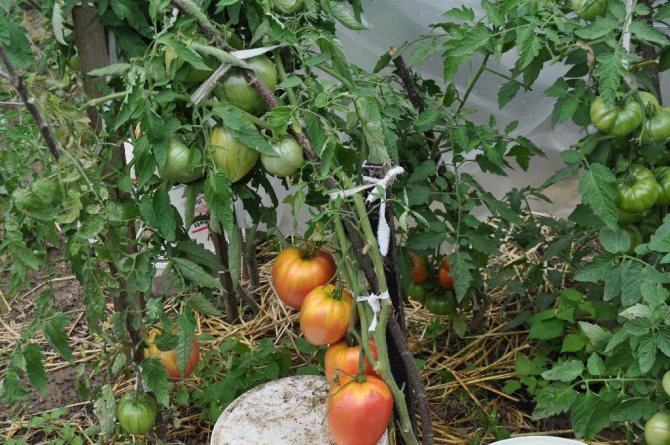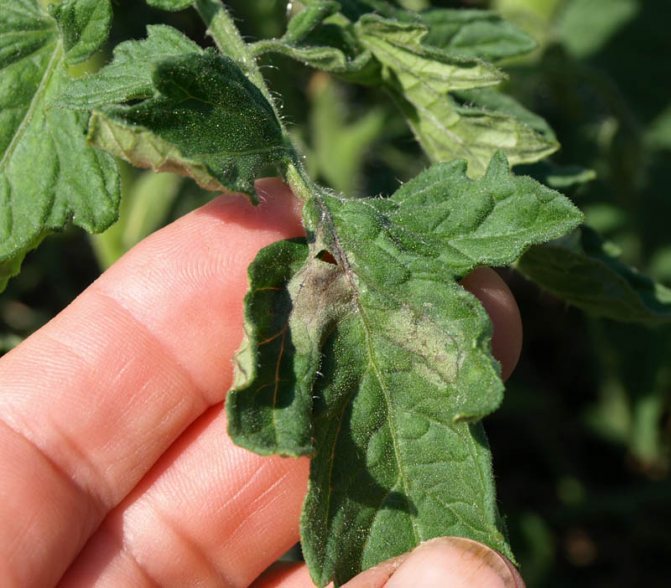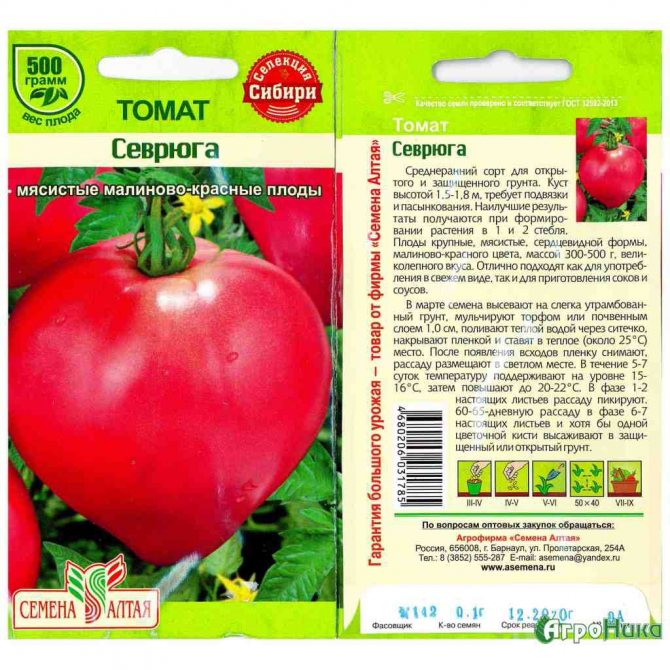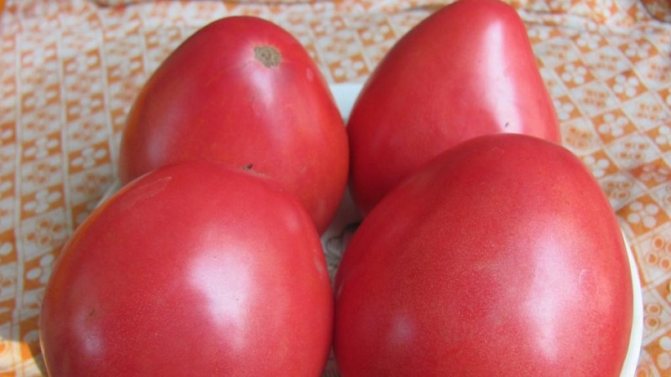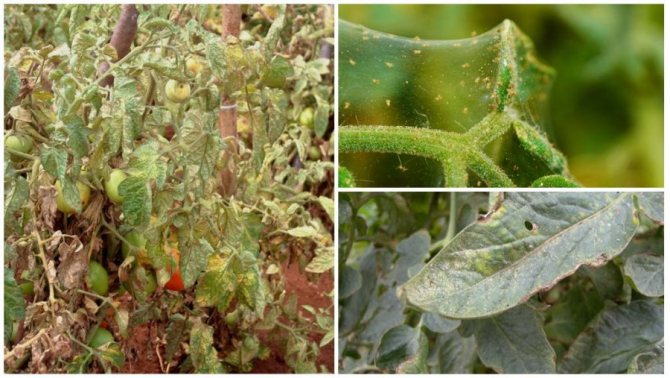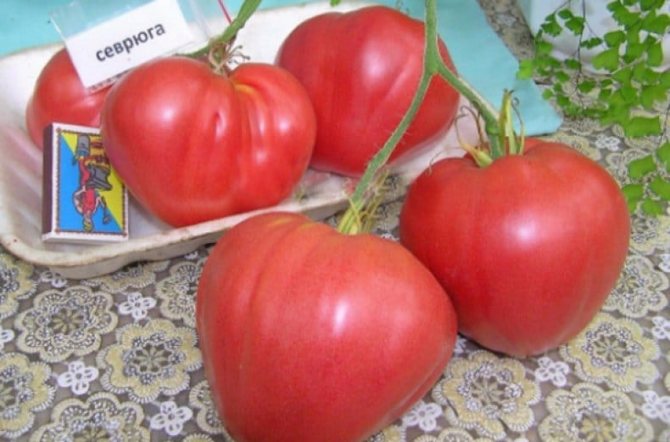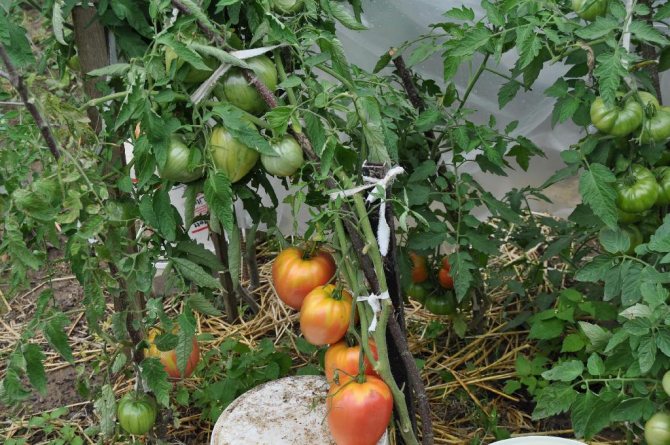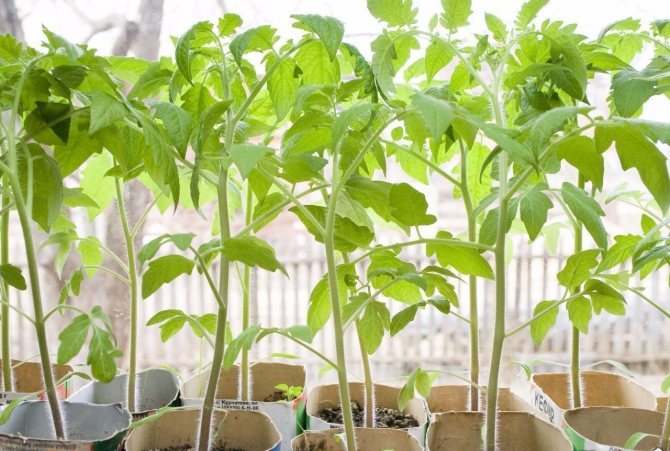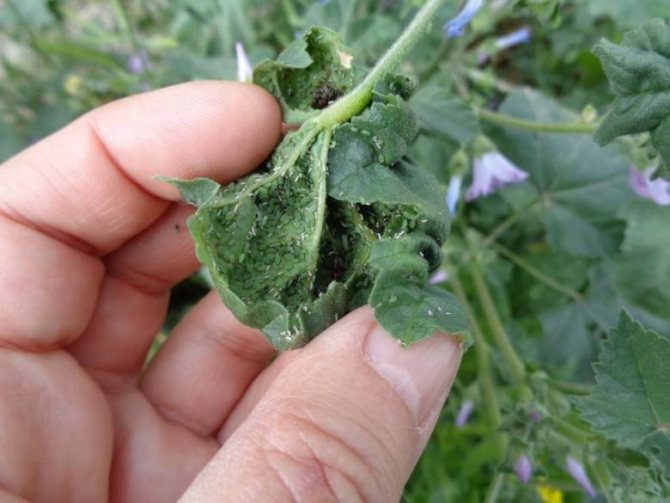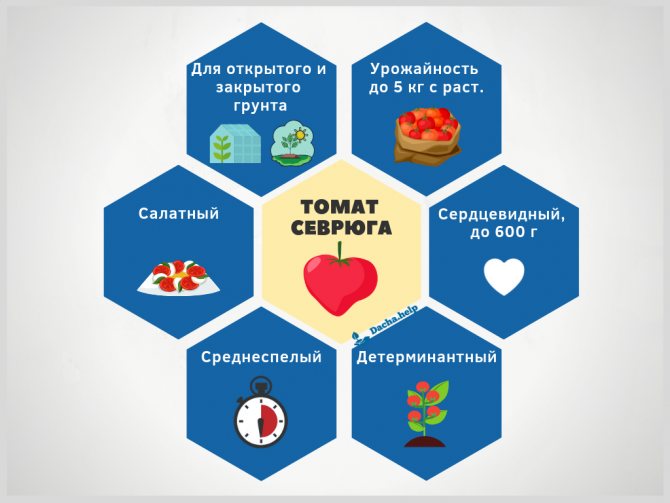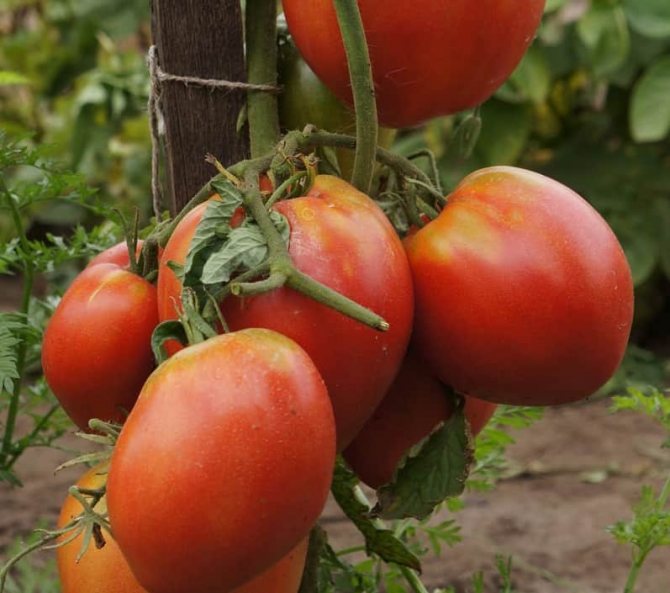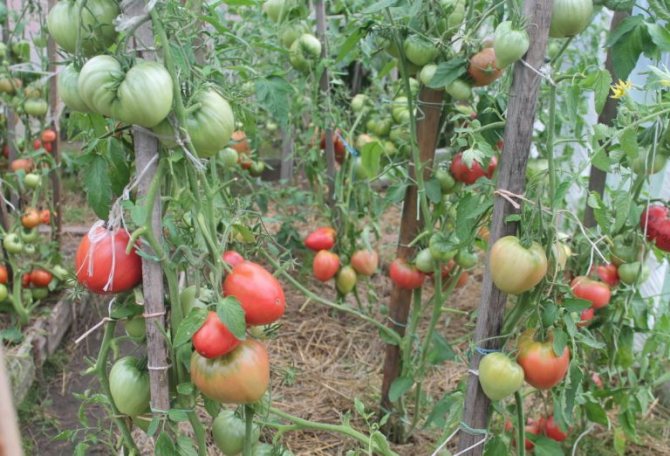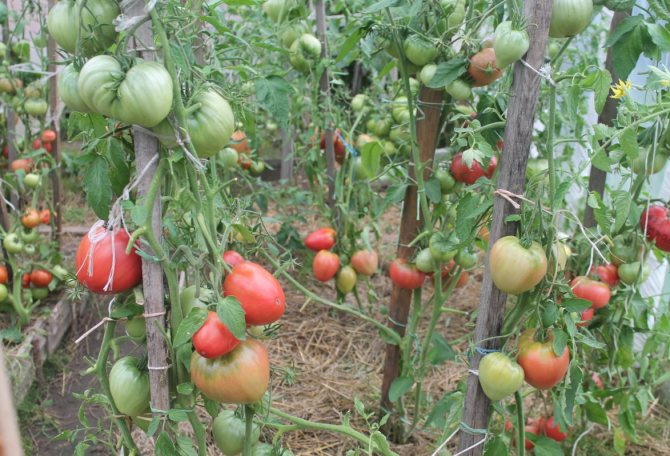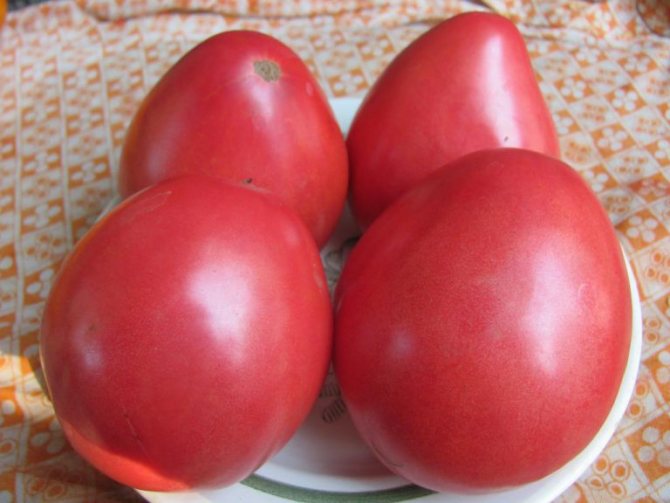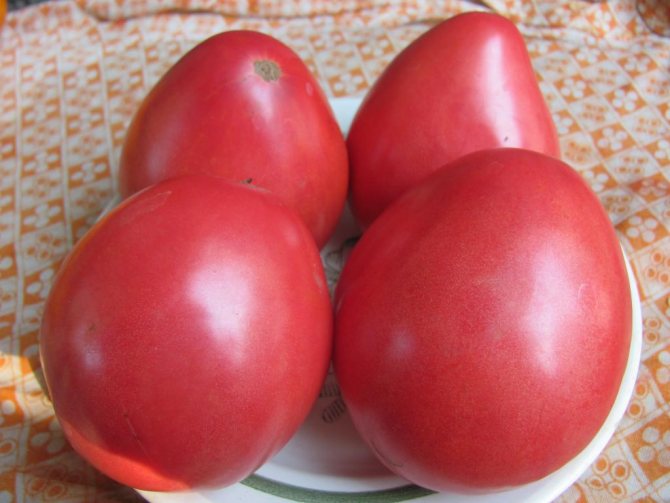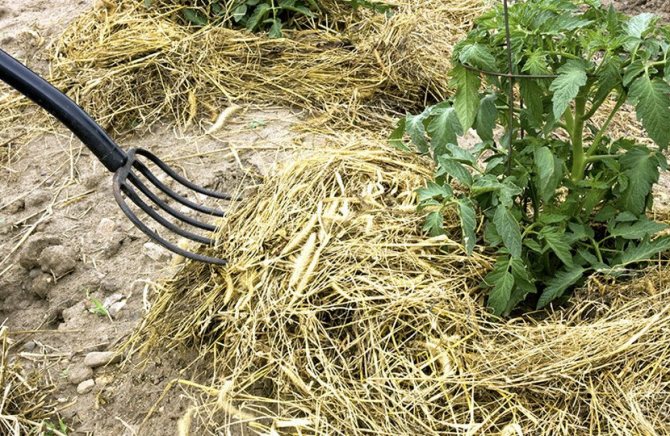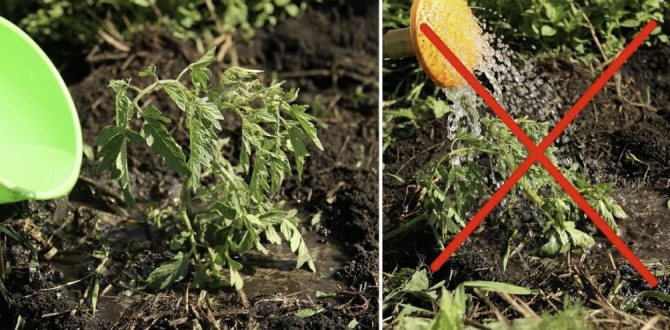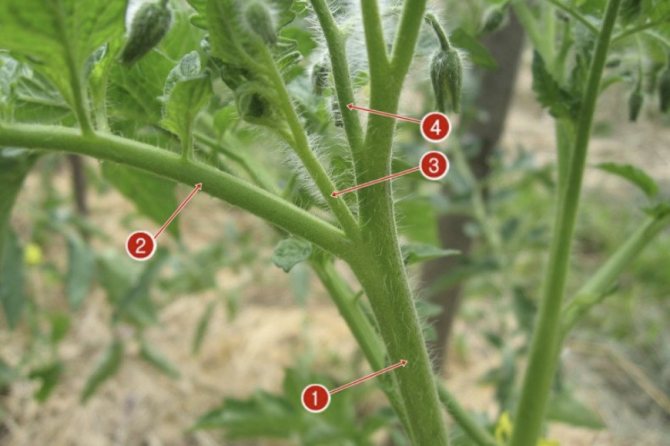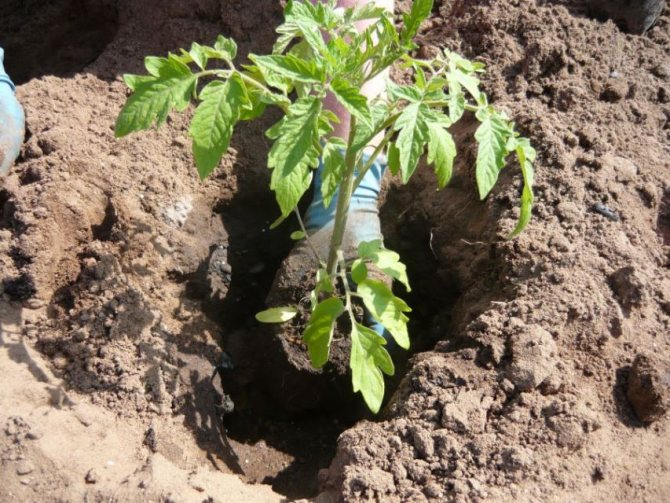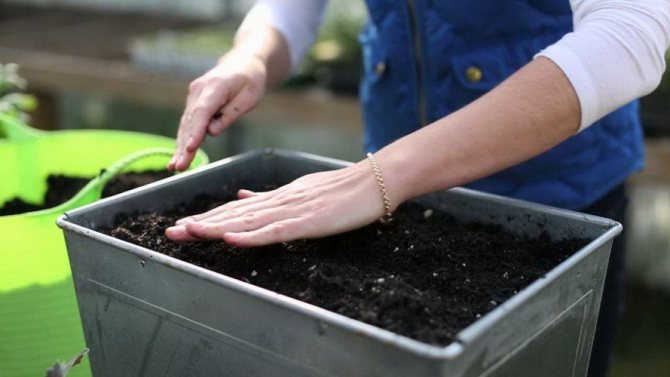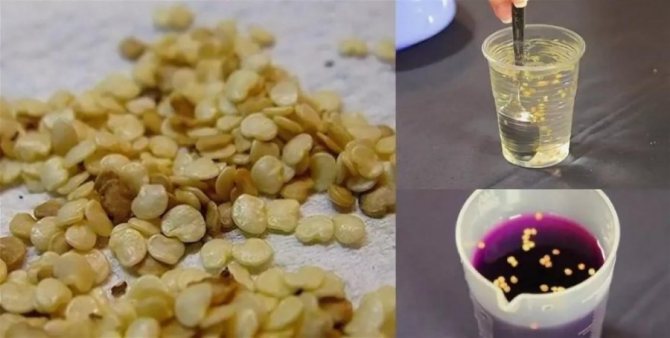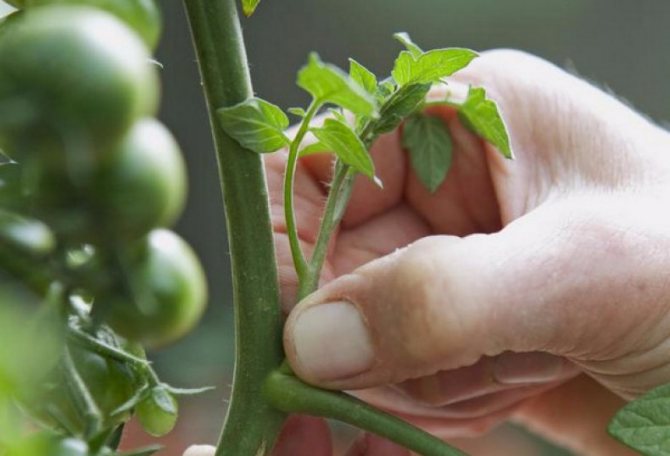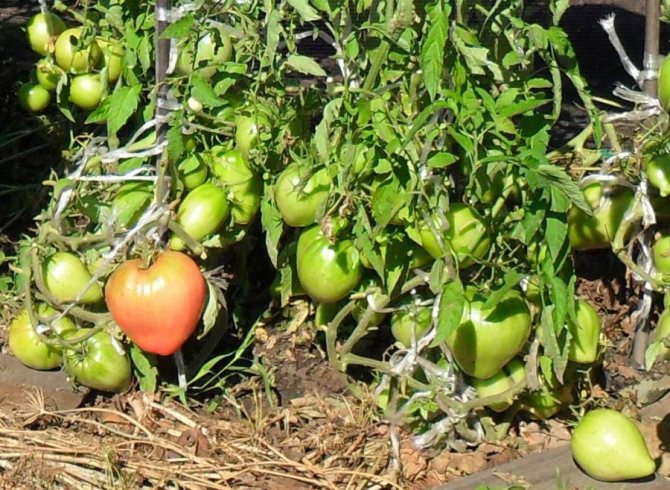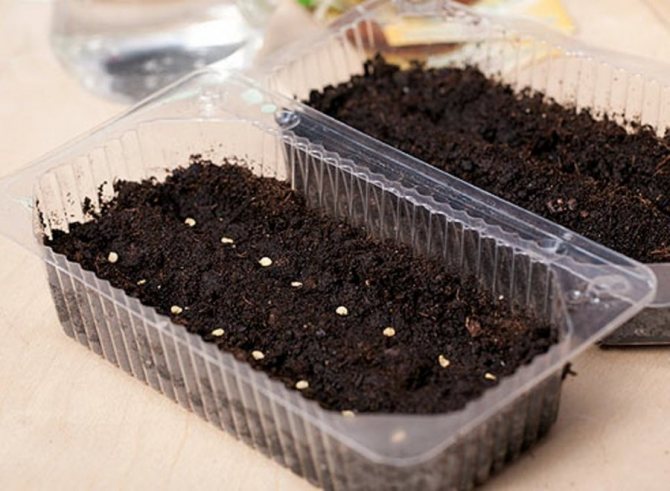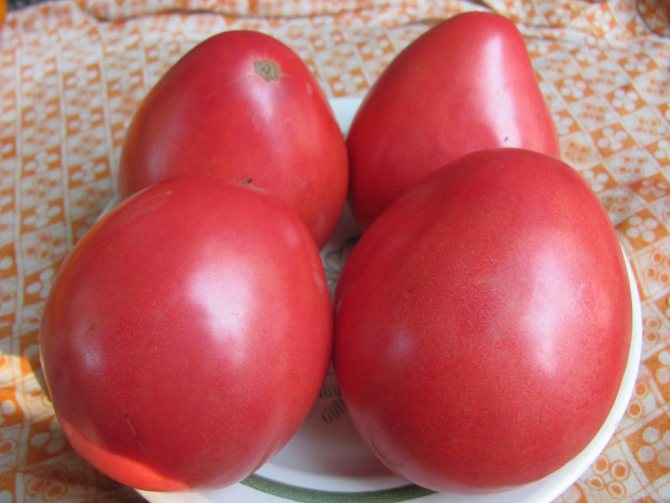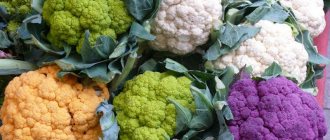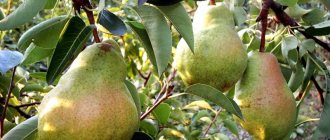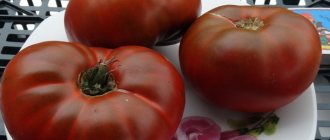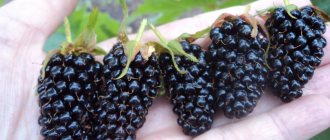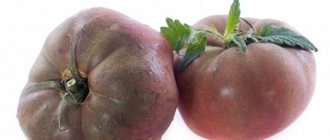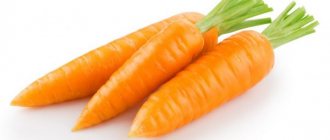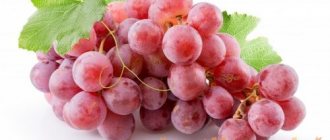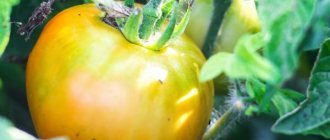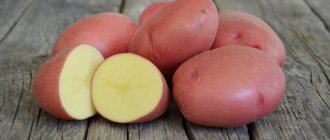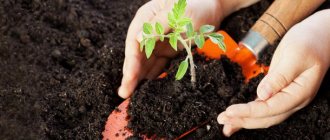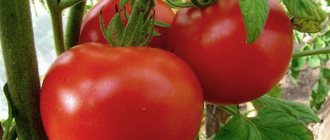Home / Garden / Tomatoes
Back to
Published: 23.07.2018
Reading time: 4 minutes
0
275
The Sevryuga tomato is not registered in the State Register of Breeding Achievements, but it is there. Ask how it is? And the fact is that Sevryuga is the popular name for the famous tomato Pudovik, which was entered in the State Register in 2007.
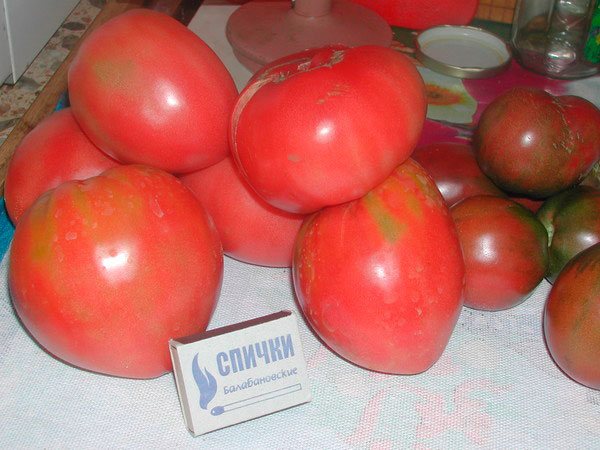
The tomato variety Sevryuga was bred by amateur breeders O.V. Postnikova and V.N. Dererko in 2005 and for two years became so fond of domestic gardeners that he easily passed the variety trials.
In the register, the tomato Pudovik (Sevryuga) has a description as an amateur variety for open ground and greenhouses. But, mainly it is grown in the beds, since a good harvest, and this is 5-6 kg per bush, can be obtained in an open place.
Have questions? Ask and get useful advice from professional gardeners and experienced summer residents. Ask a question >>
- 1 Characteristics of the variety
- 2 Description of fruits
- 3 Agrotechnics
Tomato Sevryuga - description and reviews of gardeners
I am a passionate gardener, most of my life I have been growing various horticultural crops. When I retired, I decided to turn this business into earnings - to my small dacha I bought two more with my savings, asked my daughter to create pages for me on social networks. Now I sell my crops all over the city - I have a point in the market, I have pages on social networks and there are just acquaintances who always buy my vegetables and fruits.
I can say that all my products are grown with great love - I study my business all my free time, I am constantly improving. At first I had only a few different varieties, and now there are much more - I can offer more than ten types of tomatoes, for example. In general, this vegetable is the most popular. That is why I want to tell you about one of the new varieties in my collection - Sevruga or Pudovik tomatoes.
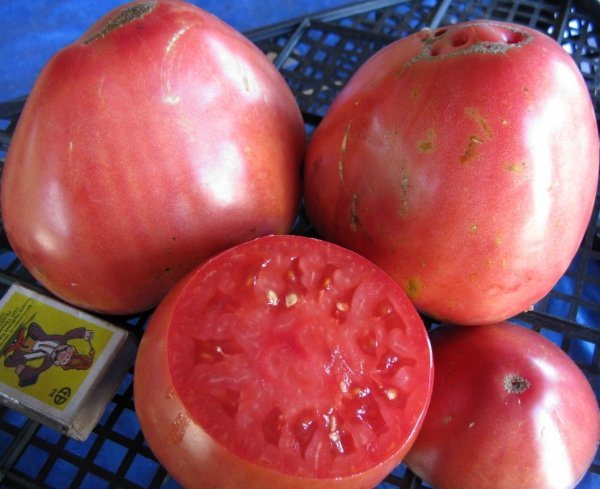

Description of plants
The Sevryuga variety is not the most popular only because it was bred not so long ago and has not yet managed to win the love of gardeners throughout Russia. But soon it will definitely happen - large, beautiful, large tomatoes and unpretentious care makes this variety just wonderful.
I cannot but note that these tomatoes were bred in Russia and they are recommended for any climatic zone. This means that the plants will not experience additional stress during planting, as is often the case with varieties bred in Europe or America. In addition, if you live in Russia, Ukraine or Belarus, you can safely plant this variety, with proper care it will take root in any region and will give a wonderful harvest.
By type, the bush is indeterminate - that is, it completes its growth by itself and does not need additional support. The plant can reach an average of two meters in height, deviations from this figure within 50 centimeters are the norm.
Bushes are tall, spreading. The shoots are powerful, strong, which is not surprising - later I will tell you why. The branches cover the leaves - they are small, in a typical tomato shape. The color is pleasant, soft green.
A very different number of tomatoes can be harvested from one bush, too much depends on planting and care, but the average yield is usually about five kilograms.
Briefly about the main
- A young variety of tomatoes grown in Russia.The plant can be planted in any climatic zone and it will not additionally adapt, unlike the varieties that were bred in Europe or America.
- Hybrid variety. These are usually considered capricious and difficult to care for, but this one is an exception, it almost does not need your time.
- Tomatoes grow very large - individual fruits up to a kilogram. Therefore, they are not suitable for conservation - they are just very large. However, Sevruga is great for salads and other fresh consumption.
- It is worth starting to plant seedlings in March or even February - it grows for quite a long time.
Fruit characteristics
I must say right away that tomatoes of this variety are very, very large, therefore, the shoots are powerful - others would not withstand the load. She herself actually removed the fruit weighing almost a kilogram - this is a lot for such a vegetable. The average weight usually ranges from 400-600 grams. On average, tomatoes are average in terms of ripening - the harvest can be harvested in about 110 days, but this figure can float quite significantly depending on the planting site, climate, weather conditions and care.
For all characteristics, tomatoes are universal for use in cooking. They are delicious fresh - great for salads and serving as a stand-alone snack. In addition, Sevryuga showed itself well in preparations - juices, pasta, various sauces. The only problem with which there may be problems is conservation. Large tomatoes do not fit into jars, and if you cut them, it will no longer be the same.
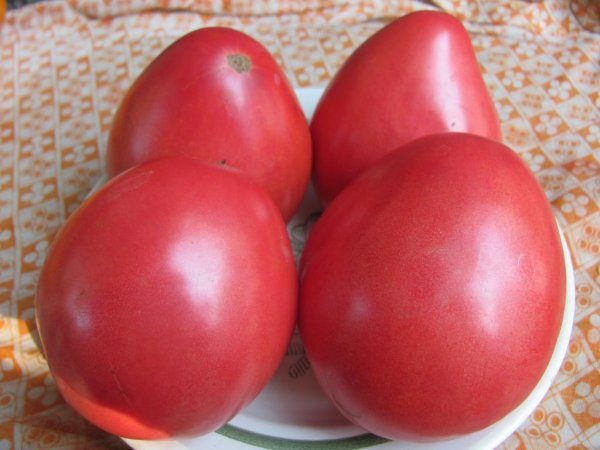

Sevruga tomato yield
Fruiting with the correct formation of bushes in the Pudovik variety can be extended in time, and the first ripe fruits are usually harvested in the last decade of July - early August (depending on the climatic conditions of the region where the Sevryuga tomato is grown).
Up to 5 kg of aromatic fruits are usually harvested from each bush of this tomato. On each square, no more than 3 Sevruga tomatoes are grown, therefore, up to 15 kg of tomatoes are harvested from 1 m2, which is a high indicator of the variety's yield.
Sevryuga tomatoes, description based on growing experience - video
Nuances of agricultural technology
- You can plant Sevryuga both in open ground and in greenhouses - the recommendations here are very simple. If you have a warm region and you live in a sunny place, plant it outdoors, but if it is more northerly and windy, then plant it in a greenhouse.
- Seedlings of this variety grow for a long time - about 80 days. Therefore, it makes sense to start planting tomatoes in March or even in February - depending on when you want to plant them in the ground.
- It is worth watering the bushes once or twice a week, no more. In general, the variety loves liquid and moisture, but if there is an excess of it, the roots will begin to rot.
- In general, this variety can be grown without fertilizers - the bushes are strong and they themselves pick up what is needed from the soil. But if you additionally feed the earth with superphosphate, the result will please you very much.
Very, very, good grade. Honestly, it feels like no others are needed, especially if you like to eat them fresh in a salad. She planted the bushes three years ago - Sevryuga only appeared then, many were afraid, it's still new. And I took a chance and all this time I am not overjoyed - I collect a huge amount of fruits from the garden, they are very fleshy, a lot of pulp, little water. It tastes amazing and looks very good - such a nice color, not directly red, but rather slightly pinkish. I advise Sevryuga to everyone who wants to suddenly have tomatoes and cannot decide on the variety.
During the five years that Sevruga has been growing with me, I noticed only one drawback - the tomatoes are so large that it is unrealistic to put them in a jar for conservation. Physically, my average fruit is 400 grams, it is simply unrealistic to preserve it. Therefore, for such purposes, smaller tomatoes had to be planted. But for everything else - only Sevruga.In salads, bake, make preparations - all this is about this wonderful variety. I highly recommend it!
Read also: What varieties of tomatoes are the most productive for greenhouses: photo description, reviews
Alexandra
I planted it this year because it was given by relatives and it was inconvenient to refuse - I doubted, of course. But I am extremely pleased with the result - large tomatoes, tasty and fleshy - I don't like it when you cut a tomato, but there is a lot of water and there is nothing to eat. They are good for making juice and other preparations, they also taste good when baked. I advise everyone to plant these plants!
Testimonials
Galina.
I grew Sevruga this year. The variety is one of the most delicious that I have eaten in my entire life. But, one drawback, due to which I will not breed en masse, is low yield. If you fail to accustom, then it will be like an additional variety. If it becomes more productive, then we will only go to Sevruga.
Nadia.
I grew this tomato this year. Impressions of the sea. The tomatoes are super. Large, 200 grams minimum! The taste is excellent, the fruits are juicy, sugar. I will continue breeding next year.
Characteristics and description of the tomato "Sevryuga"
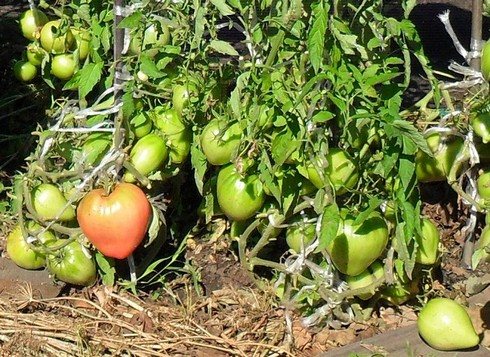

All gardeners love a good harvest. It is important to go through all the stages, from planting seeds to harvesting fruits. Delicious and popular tomatoes have a common misfortune, which is that all connoisseurs of this vegetable crop in all corners of our country want to grow them in their garden, but they often face confusion and mis-grading.
... Not all producers work honestly, and it so happens that under the guise of a popular tomato variety they will sell you something else, a clone. Confusion can even arise with the name of the variety. How did it happen with the Sevryuga tomato variety?
History of origin
Historically, the tomato, which will be discussed below, is often called Pudovik. They have identical characteristics, but there is a difference. For example, the first difference is that the Pudovik variety appeared before Sevryuga. The first was entered into the State Register of Russia back in 2007. There is no mention of the second grade in the State Register at all.
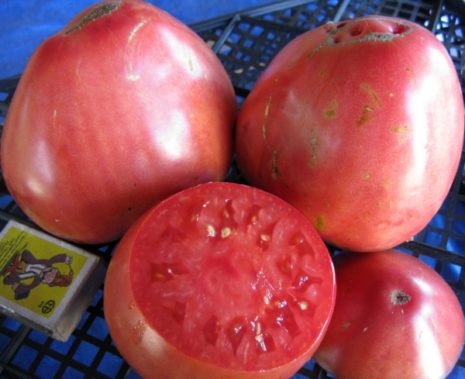

In this regard, a lot of controversy arose and the most meticulous gardeners conducted hundreds of experiments to prove the similarity of all characteristics. They grew seeds with the inscription "Sevryuga" and "Pudovik" in neighboring beds, in the same conditions, and long ago came to the general conclusion that this is the same variety.
Russian breeders bred this variety back in the 21st century. The opinion is very popular that the Sevruga tomato is the same Pudovik, but its seeds are more adapted for planting in the harsh northern conditions of Siberia. So there is an opinion that Pudovik is the official name, and Sevryuga is a popular folk name. It is believed that the tomato "Sevryuga" got its name because if you cut it, the flesh will resemble the flesh of the fish of the same name. We will look at the characteristics of plants with two names, we will learn how to grow them and how to care.
Advantages and disadvantages, features, differences from other varieties
The main feature of the Pudovik tomato is its beautiful massive heart-shaped fruits of pink-raspberry color, growing on tall, densely leafy bushes. Among similar tomatoes for salad purposes, the quality of Pudovik fruits is called the best by many gardeners. However, other amateurs say the same about the tomato Heavyweight of Siberia, and some even prefer yellow-fruited or classic red-fruited varieties. One way or another, in numerous reviews the idea is slipping that Pudovik, in terms of the totality of indicators, is one of the best salad varieties for harsh climatic conditions. Its main advantages include:
- excellent taste of tomatoes;
- wonderful presentation, large-fruited;
- high productivity;
- ease of care;
- high resistance to diseases and fluctuations in weather conditions.
The downside is the possibility of fruit cracking with significant waterlogging of the soil.
There are many lettuce tomato varieties, including heart-shaped and raspberry-colored. Perhaps the most famous are various variations of the Ox Heart, but by now the popularity of these tomatoes is gradually decreasing, since many varieties of Novosibirsk selection have bypassed the Ox Heart in terms of basic characteristics. Perhaps, the taste of the fruits of Pudovik now competes with the Heavyweight of Siberia and Altai honey, but it is not entirely correct to compare these varieties. The heavyweight of Siberia is a determinant variety with a low yield. Altai honey is grown mainly in greenhouses. The Chelyabinsk variety Raspberry Heart seems to be a very serious competitor to these tomatoes.
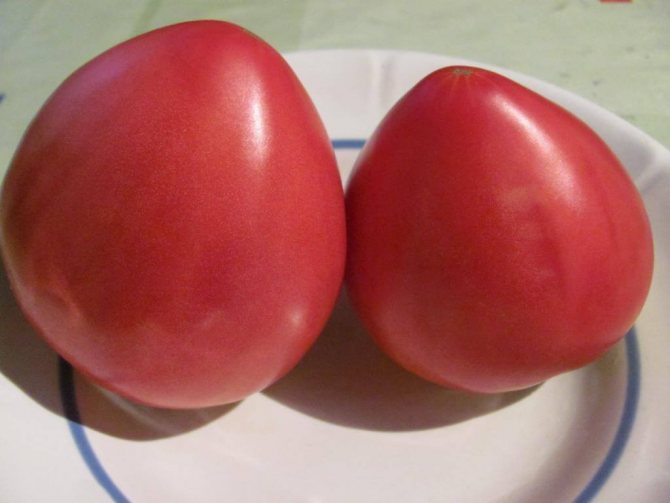

Tomato Heavyweight of Siberia is very similar to Pudovik, but it has a lower yield
Thus, according to most parameters, the Pudovik variety should be recognized as one of the best salad varieties of tomatoes that can grow in almost any conditions. Of course, it has drawbacks, but the ideal variety, apparently, will not be created for a long time.
Description of the tomato "Sevryuga"
This is an indeterminate plant. Such plants during their long life period can afford not to renew plantings in greenhouse conditions longer. They give a very high yield compared to low-growing tomatoes. "Sevruga" constantly forms generative buds, which contributes to the laying of new fruits. The plant is not a standard plant and its height reaches 1.5 meters.
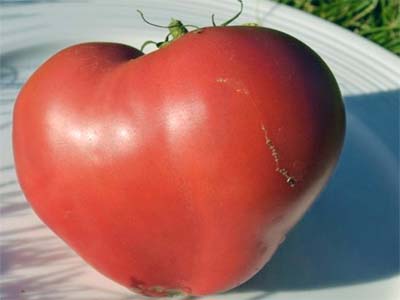

An indisputable plus of indeterminate tomatoes is that they are easy to form, and due to the fact that fruiting is extended, we will get a fresh harvest for a long time. Harvesting in some regions stretches up to September inclusive.
Disease and pest control
As a prophylaxis for diseases and pests, the plant is sprayed with various formulations. They are easy to make at home. One of the best methods is to use a weak solution of potassium permanganate. Bushes are treated with this composition before flowering to ensure the protection of future crops.
Try replacing potassium permanganate with Bordeaux liquid, which has an equally effective effect.
Garlic solutions will be effective against fungal diseases. For their preparation, you need 1.5 tbsp. Pour chopped garlic with water (10 l). The mixture is infused for a day. Then the substance is filtered and a little potassium permanganate (2 g) is added to it. It is necessary to treat the plant with such a solution during the formation of the ovary, and then every 2 weeks.
():
Garlic is used (without much success) only to repel insect pests. As a fungicide preparation, garlic tincture (as well as onion peel and the like) is absolutely useless, because and garlic and onions themselves are affected by various fungal and bacterial diseases.
Milk whey will prevent the appearance of various diseases and get rid of them when the bushes are affected. Since it is environmentally friendly, it is allowed to be used on a daily basis. Spraying with such a composition is carried out with short breaks, which should not be longer than 10 days.
Spraying with yeast-based solutions will help to cope with diseases of this tomato variety. They are prepared by mixing 10 liters of water and 100 g of yeast. This composition is used both for prophylaxis and for treatment when the first signs of disease appear. You can use both dry and fresh yeast. Greater efficiency is achieved by adding ash or nettles.
():
Yeast solution is a biological plant nutrition as it contains a wide range of useful vitamins and amino acids.
A solution of table salt will help get rid of pests. To prepare it, dilute 1 tbsp in a bucket of water. substances. With this composition, it is better to process fruits, but for now they are still green.So you can not only protect them from the influence of infections, but also scare away insects from them, which can greatly spoil the crop.
():
Salt solution will do more harm than good. He will not scare away pests, nor will he cure the disease. But to cause salinization of the soil and damage to the plant, this will follow immediately!
You can replace salt with wood ash or soda, which have a similar effect on tomatoes.
Characteristics of the "Sevryuga" variety
- They have a heart-shaped or flat-round shape.
- The shade of an unripe fruit is green. The ripe fruit has a pink-raspberry hue, which can be set off with red.
- The color of the tomato is incredibly rich, but not bright.
- Soft, juicy pulp.
- The density of the fetal skin is average.
- They do not like overflow, especially if there was a drought before. The fruit may crack from this.
- These are mid-season tomatoes. From the moment the seeds are planted in the soil to the first ripe fruit, 110 days will pass. The variety feels great in greenhouse conditions, but experienced gardeners still advise growing Sevruga in open soil.
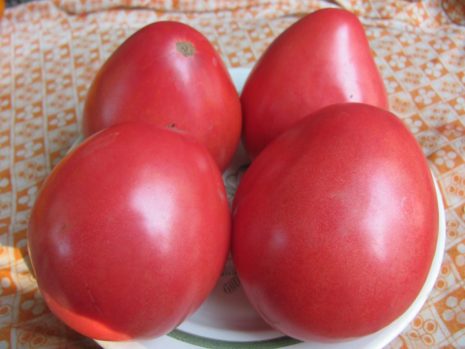

The unpretentiousness of the variety and high resistance to almost all "tomato" diseases were noted.
Growing
Sevryuga and Pudovik have proven themselves equally well in all regions of Russia. They are also planted in traditional areas in which agriculture is carried out, as well as in Siberia, where conditions are rather harsh. In any weather conditions, the fruits of the Sevryuga variety give an excellent harvest, because they are very unpretentious, and with proper care the harvest will be “at its best”.
The best time to plant is February and March. It takes about 80 days to get full seedlings, no less. After sowing, the first shoots appear in seven days. Tomatoes need to be dived.
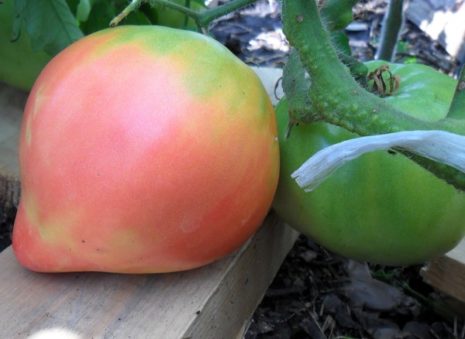

Use
The fruits have a fleshy consistency, and the taste is slightly sour. The dry matter level is medium. The number of seeds and chambers is small. The tomato is very good for long-term storage. They are used fresh, as well as processed, therefore the variety is universal. In both cases, the taste will remain the same great.
What can you cook from this tomato?
- various juices;
- salads;
- sauces;
- gravy;
- various blanks.
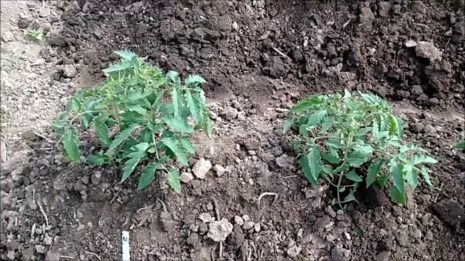

Advantages and disadvantages
Increasingly, you can find gardeners who plant this variety on their personal plot. Such popularity can be explained by the mass of its positive qualities. At the same time, its shortcomings have not been identified until today.
Advantages:
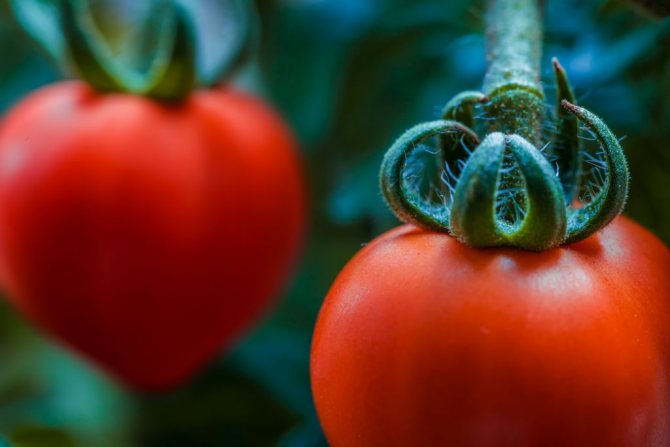

- tomato is extremely resistant to diseases characteristic of it;
- the variety is not whimsical to care for and is not difficult to grow;
- ovaries are formed in any environment;
- high productivity;
- large-fruited;
- excellent taste and versatility in the appointment;
- long-term storage.
Sevruga tomato is so unpretentious in cultivation that even a beginner can master this process. Therefore, the variety can be called considered one of the favorites among gardeners.
Yield
The fruits of "Sevryuga" often reach one kilogram. Therefore, the fruits look very impressive. One bush of these tomatoes usually gives about five kilograms of fruit. The average weight of one fruit is about 800-900 grams. The tomato needs a dive, then everything will be fine. Don't forget to harden the seedlings. I did not notice any significant disadvantages, very tasty harvest.
Read also: Tomato Batianya: description of the variety, photos, reviews
Ekaterina, Moscow Region This variety feels best at a temperature of + 20 ° + 23 ° C, it has been checked. He does not like higher temperatures, but since our summer is usually cool, there are no problems with this. If you have a fever, then it is better to refuse Sevruga.
Elizaveta, Moscow region. I advise you not to overfeed the tomato with fertilizers, otherwise it will crack. And watering should be moderate, otherwise the appearance of the tomatoes will suffer.I use mulching instead of abundant watering. You can use straw or sawdust, no difference. This saves energy, time and the tomatoes will not crack.
Sergey, Tver It seemed to me that this variety does not like watering, but on the contrary loves drought. I read the article and realized that this is indeed the case. The yield is excellent, I have never been sick. I highly recommend it to everyone!
Liza, Krasnodar Territory
The tomato needs a dive, then everything will be fine. Don't forget to harden the seedlings. I did not notice any significant disadvantages, very tasty harvest.
Care rules
After planting, it is important to tie up, form bushes. Do pinching and observe the watering regime. Disease prevention should not be neglected, despite the fact that the variety is resistant. Tomatoes also need weeding, feeding and loosening.
Garter
The garter is carried out with a soft cloth. Wire or other rigid materials injure vulnerable stems, which are pulled towards the ground by the weight of the fruit. It is required immediately after disembarkation. And then as the bush grows for formation and support.
Formation
To get neat beds and tasty tomatoes, you need to shape the bushes. They get rid of the side stepsons. Be sure to fix heavy bunches of tomatoes. In greenhouses, a leaf with a fruiting brush is removed. Pinch the top a month before removing the tomatoes.
Stepping
The variety requires compulsory pinching. New additional shoots must be cut off. Leave 2 branches for the formation of fruits. This technique will allow the plant to devote all its strength to the growth and ripening of tomatoes, and not new branches and leaves.
Watering mode
Watering should be moderate. Do not overdry tomatoes. But they shouldn't grow in strong moisture. This will lead to rotting. In addition, the bushes are heavy, they must sit firmly in the soil. Water for irrigation should be warm, not cold. Mulching is recommended.
Prevention of diseases and pests
The variety is resistant to all diseases. But prevention is inevitable. For this, spraying with non-aggressive solutions of potassium permanganate and garlic is carried out. These methods are suitable for those who do not like to use chemistry when growing. It is important that there is sufficient ventilation and the absence of "sick" neighbors.
Loosening and weeding
The soil should always be loose. Therefore, loosening should be done twice a month along with weeding. Deep processing is done first. After 3 weeks, the hinterland is reduced so as not to damage the roots. Hilling is carried out 3 weeks after planting.
Top dressing
This variety does not need strong feeding. It is important not to overdo it with fertilizers. Especially mineral. This negatively affects the taste of tomatoes. Tomatoes can be fed with superphosphates and wood ash.
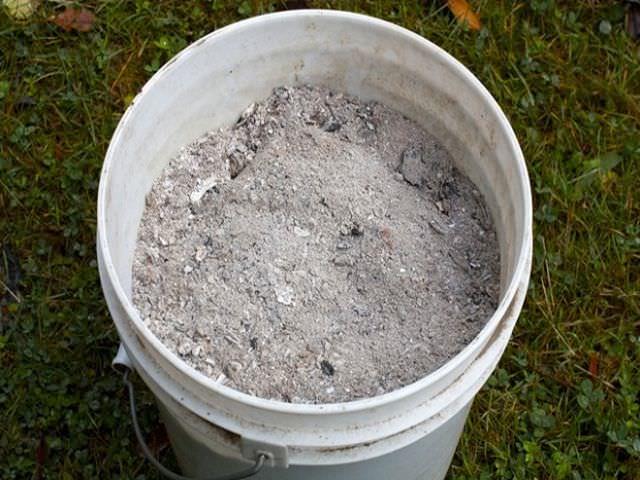

History of Sevruga tomatoes
It is difficult to find official data on this variety: who bred, in what year, varietal characteristics. Sevruga is not in the State Register of Breeding Achievements. The seeds are sold under the brands “Seeds of Altai” and “SibSad”. The latter company is famous for its mixes, as well as the ability to sell exactly the same plants under different names. So it happened with Sevryuga. Gardeners who bought the seeds of Pudovik and Sevruga at the same time discovered during cultivation that these tomatoes are identical. Moreover, on the packages with the seeds of Pudovik they sign in brackets - Sevryuga.
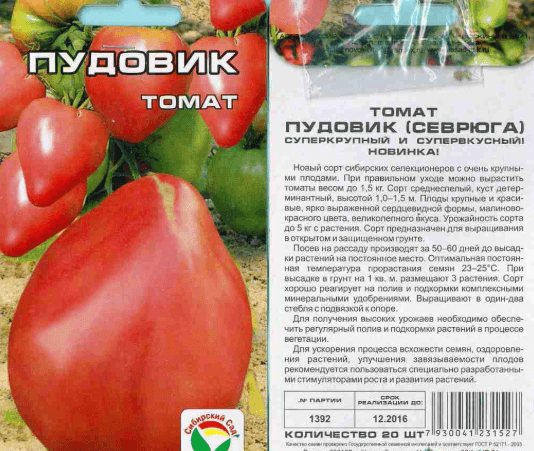

Many gardeners have long and unsuccessfully been puzzled by the question: why does one tomato have two names?
However, the Pudovik tomato is listed in the State Register of Breeding Achievements. Its authors are Novosibirsk entrepreneurs and breeders: V.N.Dederko and O.V. Postnikova. According to the description, the officially recognized Pudovik is indeterminate, that is, the main stem does not tip, grows upwards as long as the weather permits it. And he calls his Pudovik and Sevryuga - determinant, so they turn out to be when grown.
It turns out that Sevryuga has nothing to do with Pudovik from the State Register and, possibly, is sold by SibSad under different names. Nevertheless, this variety is loved by many gardeners who have been growing it for several years. Fortunately, this is not a hybrid, you can collect your seeds and not go to the store to re-grading. The idea of a tomato is easy to make from the words of members of the forum and reviews of video bloggers, as well as from the site, there is no confusion associated with Pudovik in the assortment of Pudovik.
It is known for certain that Sevryuga is a variety of Siberian selection, suitable for growing in the northern regions. It appeared about ten years ago and won the sympathy of gardeners with one unique feature - to tie large and tasty fruits on weak bushes. The first brushes are formed not somewhere at a height of half a meter, but at the very ground.
Description of Sevryuga tomato
The variety shows itself well both in greenhouses and in the open field in short summer conditions. In terms of ripening, this is a mid-ripening tomato, that is, the first fruits ripen about 100-110 days after germination. The height of the bush under the most favorable conditions is 1.5–1.8 m, and in open ground in Siberia it is less than 1 m.
More than once and more than one tomato grower called the Sevryuga bush frail: the stem is thin, strongly branches. However, rather massive fruits grow on weak branches, under their weight the plant lies on the ground.
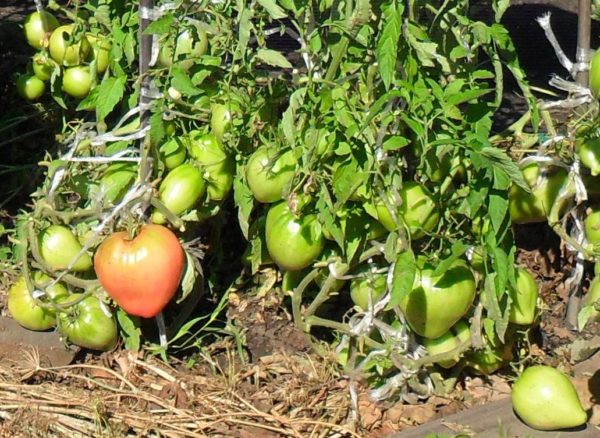

Sevruga's bush is weak, falls on the ground under the weight of its own fruits
Tomatoes are heart-shaped, ribbed, ripe are painted in a red-raspberry color. Varietal peculiarity - on the surface of ripe fruits there are spots of yellow or orange color.
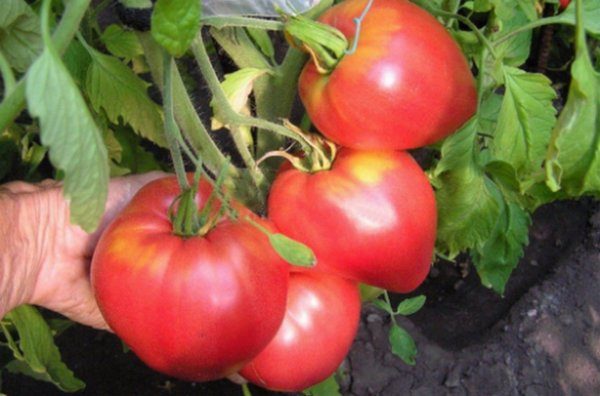

Sevryuga's business card is yellow spots on ripe tomatoes
The weight of one tomato is 200-300 g, individual specimens - up to 500-600 g. The fruits are unaligned. Even in one brush, different sizes can be poured. The taste is very good, the pulp is sweet, fleshy, with a tomato aroma. Some gardeners call Sevryuga the most delicious among all the varieties available on their site.
- in drought and heat, flowers fall off without forming ovaries;
- the skin of ripe fruits is soft, a dent remains from pressing with a finger, the variety is not easy.
The purpose of Sevruga tomatoes is salad, they are eaten fresh, and the surplus is processed into juices and sauces.
Video: Sevryuga tomatoes ripen on bushes (Altai Territory)
Description of the variety
So, the Pudovik tomato, which serves as the twin brother of the Sevryuga tomato, was bred by the famous Russian breeders Vladimir Dederko and Olga Postnikova in 2005. Since 2007, it has appeared in the state register and began to explore the vastness of Russia, either under its own name or under the name of Sevryuga.
It is declared as an indeterminate variety, although in this regard there are already differences of opinion among gardeners.
Attention! Some of those who have grown the Sevruga tomato variety warn that it is semi-determinant, as one of its stems ends its growth at some stage of development.
Therefore, it is necessary to be careful with pinching it. It is better to always keep one of the most powerful stepsons in reserve, which can continue the development of the bush. Otherwise, the yield may be minimal.
Manufacturers also do not say anything about the height of the bush, meanwhile opinions here also differ greatly. For some gardeners, the bushes reached only 80 cm, however, when grown in the open field. For many others, the average height of the bush was 120-140 cm, even when planted in a greenhouse. Finally, some note that their Sevruga tomato bushes reached 250 cm in height. And this is with the same size, shape, color and other characteristics of the fruit.
In general, everyone notes that Sevruga tomato bushes branch easily and, having weak and relatively thin stems, lie under their own weight. Therefore, in any case, tomatoes of this variety need a garter.
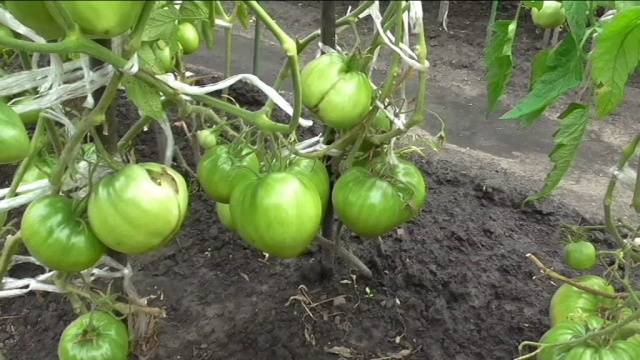

The inflorescence is a simple raceme, the stalk has an articulation.
Sevruga tomato ripens in the traditional terms for most tomatoes - at the end of July - August. That is, the variety is mid-season, since a total of 110-115 days pass from germination to harvest.
The declared average yield is quite decent - 15 kg of tomatoes can be harvested from one square meter and even more with careful care. Thus, the yield from one tomato bush is about 5 kg of fruit.
Comment! Sevruga tomato is positioned as the most resistant to adverse weather conditions, drought, high humidity, low temperatures.
But still, in order to obtain maximum yields, it is better to provide tomatoes with good conditions and careful care.
Sevruga tomato also has good resistance to a standard set of tomato diseases. Therefore, you can try to grow it even for novice gardeners.
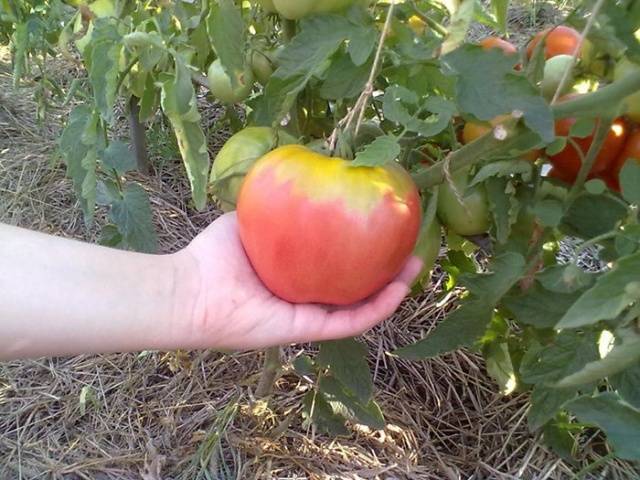

Growing features
Sow Sevryuga seeds in March so that by the time of planting on a permanent place, the seedlings are 60–65 days old. At a temperature of +25 ° C, seedlings will appear 7-10 days after sowing. For the first 5–7 days, keep them on a light and cool windowsill at + 15… +16 ° C, then the temperature should be gradually increased to + 20… +22 ° C. Such precautions will prevent stretching, because this variety tends to form thin stems even in the open air.
Read also: Cucumbers Gherkins: the best varieties, characteristics
In the phase of 1-2 true leaves, plant the seedlings in pots. Water the tomatoes regularly as the topsoil dries. Feed the seedlings with fertilizers once every two weeks: Fertika Lux, Agricola, Clean Leaf. Plant in open ground when the threat of frost has passed, and under cover material or in a summer greenhouse 1–2 weeks earlier. By this time, the seedlings should already have 6–7 leaves and a nascent flower cluster.
There are no exact and official recommendations for the landing pattern. According to SibSad, 3 bushes can be placed on 1 m². You need to form in 1-2 stems. However, Siberians successfully grow Sevruga according to the 50x70 cm scheme, while planting 2 plants per hole. In the open field, the bushes grow more spreading than tall. Therefore, they are not even tied to stakes, but are placed under the fruits of the board. Apparently, gardeners do not believe in Sevryuga's ability to withstand heavy brushes weighing more than 1 kg each on thin shoots, and on a bush there are from 4 of them with single-stem formation and up to 8 if formed into 2 stems. Be sure to remove all stepchildren, otherwise you will not get large tomatoes.
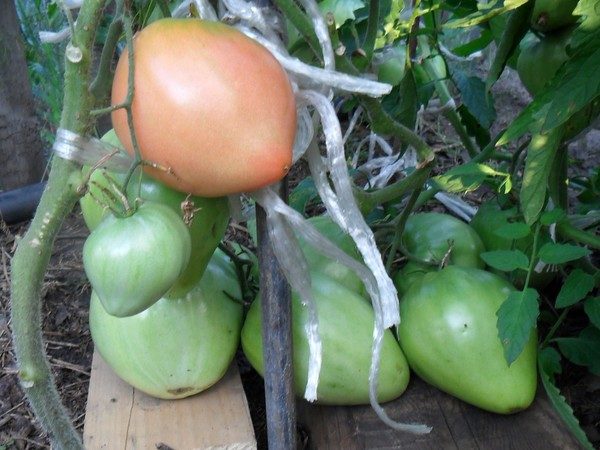

To avoid cracks in the bush, it is better not to tie it up, but to wait under the fruit of the board
The rest of the care for Sevruga is classic:
- watering 1-2 times a week with warm, settled water;
- root dressing 2 times a month with special fertilizers for tomatoes or universal for vegetables under the brands Red Giant, BioMaster, etc .;
- foliar feeding during mass flowering with boric acid, Epin, Ovary or Bud;
- weeding, loosening the soil or covering it with mulch.
In areas with a short summer, it is better to remove tomatoes from the bushes with blange, and the remains at the end of the season are completely green. In early August, pinch the tops of the stems and remove all flowering clusters. Tomatoes from them will no longer grow, and the bush will spend energy on them, and to the detriment of the already existing fruits.
How to grow seedlings
Planting seedlings is a very crucial stage. It is necessary to follow not only the recommendations of experienced gardeners, but also take into account the individual conditions. This is a feature of the soil, climate, proximity to other crops.
What should be done:
- Choose a time frame.
- Prepare the seeds.
- Prepare the ground and container.
- Sow.
- Courtship, dive.
- Temper.
- Planting.
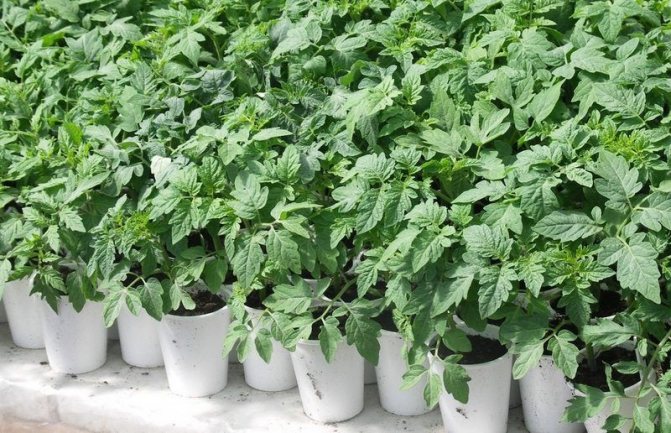

Important! The timing of planting and planting seeds should be calculated based on the weather conditions of the region.
Timing recommendations
You need to choose the timing based on the time of seed germination. From the moment of sowing to germination, it takes about 7 days. And from sowing to disembarkation - about 2 months. You need to immerse the plant in the already prepared soil, enriched, warmed up. Weather conditions must be stable, without temperature extremes. Recommended seed distribution time is February-March. They are transferred to a vegetable garden or greenhouse after 50-60 days.
Important! If acclimatization takes place, you need to tie up the bushes.
Seed preparation
Seeds must be prepared before planting in a container. To do this, choose the largest ones and start soaking:
- Immersed in a warm solution of water and salt. Drain the liquid.
- Take the seeds remaining below and rinse in clean water. Etched with potassium permanganate. Washed out.
- Soak for 12 hours in a solution of 1 liter bales. water + a spoonful of wood ash, copper sulfate on the tip of a knife.
In the meantime, prepare the soil and container for planting.
How to prepare the soil and container
The soil can be from the garden. Forest soil is encouraged. The earth should be slightly acidic. Plants love loose soil, with lots of organic matter and fertilizers. Ideal for growing black soil.
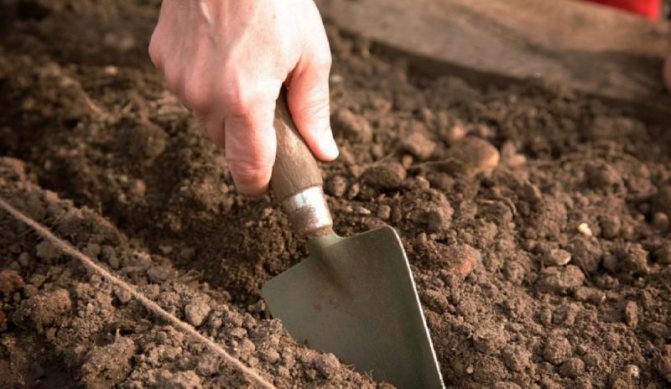

Important! Fresh manure must not be added.
The soil is not taken from those beds where potatoes or eggplants were previously grown. And from the places where aphids, fungal pests and a virus were found.
For good growth, humus is already added to the beds. It is recommended to extract peat. But it must be aged for at least 3 years.
Expert opinion
Stanislav Pavlovich
Gardener with 17 years of experience and our expert
Ask a Question
Wooden boxes or cups are taken as containers.
Sowing and follow-up care
After soaking and preparing the soil, sowing is carried out. Further care is required before disembarking in an open area.
- Treat the seeds with stimulants.
- Form holes in the ground and place the seeds 2 cm deep.
- Sprinkle with a loose layer of earth.
- Place the container in a warm place out of direct sunlight.
- Move the box to the light when the seeds hatch.
- Move the seedlings to an open germination site after 60 days.
The room temperature should be between 22-23 degrees.
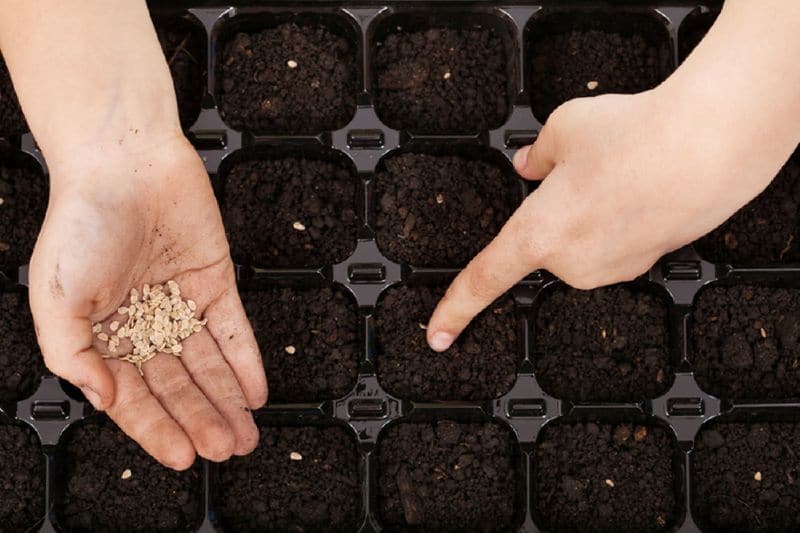

Expert opinion
Stanislav Pavlovich
Gardener with 17 years of experience and our expert
Ask a Question
Watering should be moderate, regular. Humidity 60%.
Picking
A pick is necessary for seedlings for normal growth. This is the process of planting plants in separate containers. The appropriate time for the process is 7-10 days. At this time, the first 2 sheets should appear. It is necessary to dive carefully. The transplant is carried out together with the ground. This will prevent root trauma.
Expert opinion
Stanislav Pavlovich
A gardener with 17 years of experience and our expert See also the Characteristics, description and features of growing a tomato variety Gulliver
Ask a Question
During transplantation, it is recommended to select frail plants. And also supplement the soil with useful substances.
Hardening
Hardening is necessary so that when planting in a garden or greenhouse, the plant does not have strong acclimatization. Temperature changes, surges and wind can kill unseasoned tomatoes.
A week after the seeds sprout, preparation is carried out. The temperature is lowered by opening the window for three hours. The procedure is carried out in the morning and evening. Then the containers are taken out into the street. The time is increased daily by 1 hour. Before transferring the plant to the ground, you need to leave the seedlings outside for 3 days.
Important! Do not carry containers in windy or rainy weather.
Landing in open ground
Landing in the ground is carried out extremely carefully. The stem of tomatoes is often weak. For 1 sq. m. 3 bushes are placed. A two-stem garter is carried out.Or leave one, but place 4 bushes on this area. In the early days, it is important to monitor the condition of the plants.
